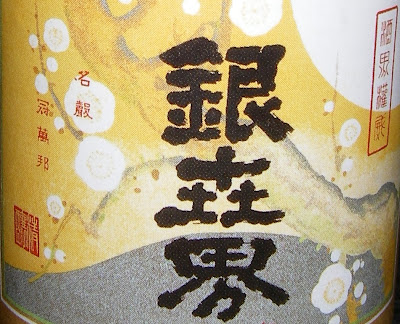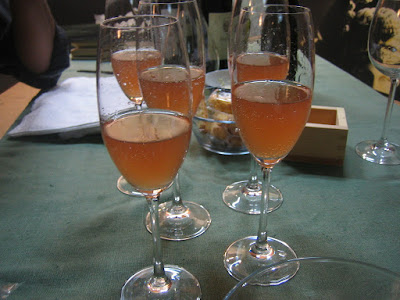 Tonight R. and I attended an importer tasting of the wines of Rolly Gassmann, from the village of Rorschwihr in the Alsace. Rolly Gassmann... producer with a good reputation, no Grand Cru sites, uncertified biodynamic, and a penchant for sweetness. The Alsace has not held much joy for me, but I'm open to trying, plus R. loves Gewürztraminer.
Tonight R. and I attended an importer tasting of the wines of Rolly Gassmann, from the village of Rorschwihr in the Alsace. Rolly Gassmann... producer with a good reputation, no Grand Cru sites, uncertified biodynamic, and a penchant for sweetness. The Alsace has not held much joy for me, but I'm open to trying, plus R. loves Gewürztraminer.2001 Auxerrois Moenchreben (12% abv): Full-on nose, apple, pear, tropical fruit, chalky minerality. Light-medium body, good acidity, nicely balanced, sweet but not too sweet, with a nice, clean springwater and bitters finish. R.'s favorite on the evening. [$27]
2006 Riesling (13% abv): Warm topaz colour, very perfumed-nose, smells like a dessert wine, honeyed, candied orange peel, spice. Again light-medium body, again not quite as sweet as I'd expected, lots of pineapple, unripe tropical notes, some cidery touches, good acidity, well-balanced. [$29]
2004 Riesling Kappelweg (12.5% abv): Lighter in colour than the first riesling, an even more perfumed-nose, full-on tropical fruit, plus apricot jam and apple juice. Surprisingly light and restrained on the palate - I wouldn't call it dry, but the balance is terrific, light funk, mineral water, and a clean finish. My favorite wine of the evening. [$60]
2004 Pinot Gris (13% abv): Very tropical nose, bordering on over the top, with some oxidative and cotton candy notes. Full bodied, but rather soft. This didn't work for me. [$40]
2004 Gewürztraminer (13% abv): Odd. Would never pick this out as Gewürztraminer. Very flat nose, one-note palate, all sugar. Importer reckons that this needs more bottle age. Whatever it was, this was a no-show. [$37]
2001 Pinot Gris Vendages Tardive (12% abv): Curious nose, smoky, musty, bitter leafy greens, seashells. Medium+ body, good acidity, structurally well-balanced, yet it left both of us flat. Just not much complexity, actually a little dirty tasting. [$67]
Well, it was a solid start and a not so great finish. Still sweeter than I like generally, but the Rieslings and Auxerrois were well contained. The prices though, can't say I'm much inclined to buy.



 From Hiroshima's Aihara Shuzo - here's an interesting brewery - ONLY makes Daiginjo!! This is one is milled down to 40%, SMV +4, acidity 1.2, amino acidity 1.0, #9 yeast, 15-16% abv. Very aromatic nose, melons, but also herbal and yeasty touches. On the palate, nicely balanced, alcohol is well integrated - round and full, more than I'd expect, but decent acidity at the end. Sweet melon and rice mash, but also savoury and vegetal elements - jicama and celery. Not sure of the rice here - one of the kanji is "machi" so I'd think omachi, but I don't recognise the first character. Doesn't taste like omachi either.
From Hiroshima's Aihara Shuzo - here's an interesting brewery - ONLY makes Daiginjo!! This is one is milled down to 40%, SMV +4, acidity 1.2, amino acidity 1.0, #9 yeast, 15-16% abv. Very aromatic nose, melons, but also herbal and yeasty touches. On the palate, nicely balanced, alcohol is well integrated - round and full, more than I'd expect, but decent acidity at the end. Sweet melon and rice mash, but also savoury and vegetal elements - jicama and celery. Not sure of the rice here - one of the kanji is "machi" so I'd think omachi, but I don't recognise the first character. Doesn't taste like omachi either.
 It was an absolutely beautiful evening tonight, we decided to take in some evening sun on the balcony, and I had a hankering for something pink. Scarbolo to the rescue. Ramato means copper, and this wine has such a pretty colour - according to Valter, this is the natural colour for this grape, really reminds me of those Austrian Schilchersekts... this wine, half cold macerated, half skin-fermented. Lots of nectarine, orange peel (R. says Mandarins) and smoke on both the nose and palate. Much more depth than the usual PG, good acidity and full of mineral and bitters. A little "darker" than
It was an absolutely beautiful evening tonight, we decided to take in some evening sun on the balcony, and I had a hankering for something pink. Scarbolo to the rescue. Ramato means copper, and this wine has such a pretty colour - according to Valter, this is the natural colour for this grape, really reminds me of those Austrian Schilchersekts... this wine, half cold macerated, half skin-fermented. Lots of nectarine, orange peel (R. says Mandarins) and smoke on both the nose and palate. Much more depth than the usual PG, good acidity and full of mineral and bitters. A little "darker" than 





 Cold, miserable wet night in Philly. Having spent a few hours on the river out in the elements, I was definitely in the mood for a "pick-me-up", and this fit the bill. I'm not entirely sure why, but we've got several bottles of Iceland's
Cold, miserable wet night in Philly. Having spent a few hours on the river out in the elements, I was definitely in the mood for a "pick-me-up", and this fit the bill. I'm not entirely sure why, but we've got several bottles of Iceland's 
 From Yamagata Honten in Yamaguchi Prefecture. Made from Yamada Nishiki rice milled to 60%, SMV +3, acidity 1.5, and 14.5% abv. Curious label, that reads kahori in hiragana and kaori in English. Same on the website, some mystery here. Full, sweet, nutty nose, with a light marine element. Unlike the brewer's notes, I did not detect any muscat. Not even close. Banana? Maybe. On the palate, this was rather full and yeasty, felt almost unfinished, kind of zingy. Good acidity, with some nutty and spicy highlights. Again, completely in contrast with the brewer's notes, this was not light-bodied and neutral. Not sure what's going on? This has certain hineka elements, but not convincingly, and unfortunately, the label didn't provide the brewing date. All that said, I found this more than tolerable, but will not be topping any lists.
From Yamagata Honten in Yamaguchi Prefecture. Made from Yamada Nishiki rice milled to 60%, SMV +3, acidity 1.5, and 14.5% abv. Curious label, that reads kahori in hiragana and kaori in English. Same on the website, some mystery here. Full, sweet, nutty nose, with a light marine element. Unlike the brewer's notes, I did not detect any muscat. Not even close. Banana? Maybe. On the palate, this was rather full and yeasty, felt almost unfinished, kind of zingy. Good acidity, with some nutty and spicy highlights. Again, completely in contrast with the brewer's notes, this was not light-bodied and neutral. Not sure what's going on? This has certain hineka elements, but not convincingly, and unfortunately, the label didn't provide the brewing date. All that said, I found this more than tolerable, but will not be topping any lists.
 From Yamamoto-Honke, in Nara Prefecture, this "demon slayer" is variously described as a honjozo or a futsushu. I'm leaning towards the latter, as apart from the 16% alcohol, absolutely no other details are provided. Tastes "older" than the last time I tasted this, lighter in the nose, cleaner, but still tangy. On the palate, still very dry, crisp, with a bitter finish, but the sweet component was more fullsome. Still, quite ok, but probably not buying a bottle for myself again.
From Yamamoto-Honke, in Nara Prefecture, this "demon slayer" is variously described as a honjozo or a futsushu. I'm leaning towards the latter, as apart from the 16% alcohol, absolutely no other details are provided. Tastes "older" than the last time I tasted this, lighter in the nose, cleaner, but still tangy. On the palate, still very dry, crisp, with a bitter finish, but the sweet component was more fullsome. Still, quite ok, but probably not buying a bottle for myself again.
 The ginjo-shu that started it all. From Yamagata Prefecture, semaibuai 50%, SMV +5, acidity 1.2, 15.5% abv. Made from Miyama-nishiki and Yukigeshyo rice, and #10 yeast. Unmistakable nose, highly perfumed, abundantly floral with melon and pear juice. On the palate, melon-infused spring-water, with good acidity, and a light bitter finish. Medium++ bodied, smooth, clean, and "sweet", yet not sweet, yet sweeter than my normal preference, yet I could drink this all day.
The ginjo-shu that started it all. From Yamagata Prefecture, semaibuai 50%, SMV +5, acidity 1.2, 15.5% abv. Made from Miyama-nishiki and Yukigeshyo rice, and #10 yeast. Unmistakable nose, highly perfumed, abundantly floral with melon and pear juice. On the palate, melon-infused spring-water, with good acidity, and a light bitter finish. Medium++ bodied, smooth, clean, and "sweet", yet not sweet, yet sweeter than my normal preference, yet I could drink this all day.



